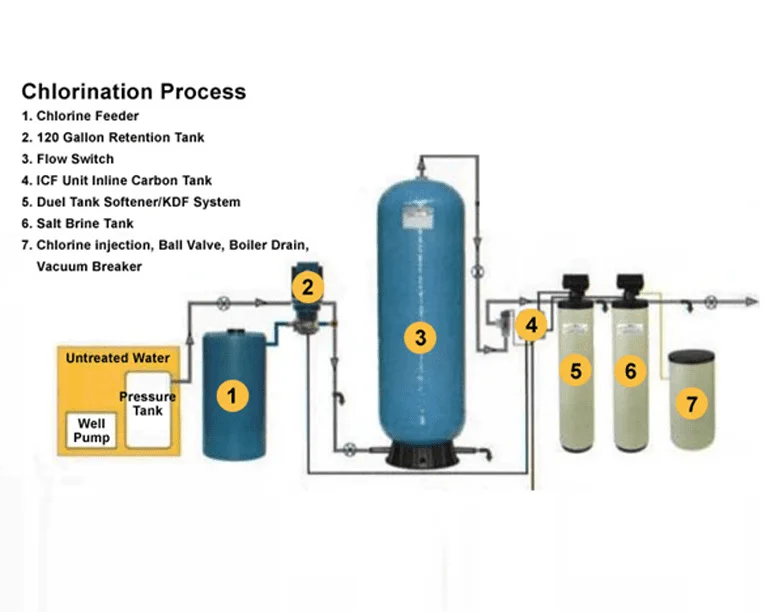Chlorination System
Chlorination Systems – Reliable Disinfection at Low Cost
Chlorine-based systems are a proven and cost-effective solution for eliminating bacteria and viruses from water sources, making them a widely adopted method for water disinfection.
At Water Care Services Pakistan (WCSP), our standard chlorination setup includes a chemical dosing pump that accurately injects diluted chlorine into the incoming water stream. The treated water is then held in a contact tank, allowing sufficient time for disinfection. These tanks come in various capacities, and a minimum contact time of 20 minutes is required for optimal effectiveness. After disinfection, any excess chlorine is removed to preserve the water’s taste and odor.
Key Features
Effectively eliminates harmful bacteria, including coliforms and E. coli
Removes unpleasant hydrogen sulfide (sulfur) odors
Oxidizes iron and manganese, making them easier to filter
Economical and efficient solution for water treatment

Types of Chlorination Systems

Gas Chlorination
Gas chlorination introduces chlorine gas directly into the water, offering a highly efficient solution for large-scale disinfection. It is a preferred method in municipal water treatment plants due to its effectiveness and scalability.

Liquid Chlorination
Liquid chlorination uses chlorine solutions to disinfect water with precise dosage control. This method is highly reliable and widely employed in industrial and commercial water treatment applications.

Tablet Chlorination
Tablet chlorination involves the use of slow-dissolving chlorine tablets, which release chlorine gradually into the water. It is ideal for small-scale systems, such as residential water treatment units and swimming pools, where ease of use and low maintenance are key.
Ensure Safe and Clean Water—Talk to Our Experts
chlorination system is a water treatment method that involves the introduction of chlorine into water to disinfect it and eliminate bacteria, viruses, and other harmful microorganisms.
The chlorination system works by adding chlorine, typically in the form of gas, liquid, or solid tablets, to water. Chlorine reacts with organic and inorganic substances in the water, destroying pathogens and preventing the spread of waterborne diseases.
Chlorine is a powerful disinfectant that effectively kills bacteria, viruses, and other microorganisms in water. It is widely used in water treatment to ensure the safety of drinking water and to prevent the spread of waterborne diseases.
Chlorination systems come in various forms, including gas chlorination, liquid chlorination, and tablet chlorination. Each type has its advantages and is suitable for different applications.
Yes, chlorinated water is generally safe to drink within regulated limits. The chlorine levels in treated water are carefully monitored to ensure they meet safety standards and do not pose health risks.
Excessive chlorine levels in drinking water can be harmful. However, water treatment facilities carefully control and monitor chlorine levels to ensure they are within safe limits according to regulatory standards.
The dosage of chlorine in a chlorination system is determined based on factors such as the water volume, quality, and the target level of disinfection. Water treatment professionals use established guidelines to calculate the appropriate chlorine dosage.
Yes, there are alternative water disinfection methods such as UV treatment, ozonation, and chloramine disinfection. The choice of method depends on various factors including water quality, cost, and specific treatment requirements.
Regular maintenance of a chlorination system involves monitoring chlorine levels, checking equipment for wear and tear, and ensuring proper functioning of the system. Routine inspections and calibration are essential for optimal performance.
Yes, chlorination systems are commonly used for disinfecting swimming pool water. They help maintain water quality by eliminating bacteria and preventing the growth of algae, ensuring a safe and enjoyable swimming environment.
